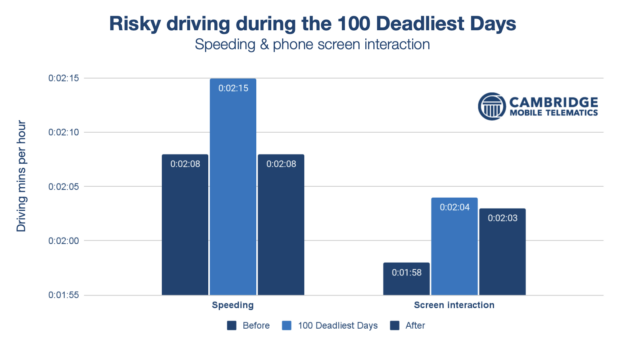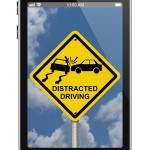Nearly half of all teen auto fatalities happen during the 100 Deadliest Days — the period between Memorial Day and Labor Day, according to a new report by Cambridge Mobile Telematics (CMT) that highlights the increased risks teens face on the road.
During the summer from 2012 through 2021, over 7,300 people were killed on the road in teen-related crashes. In 2021, nearly 900 died in these types of crashes during the 100 Deadliest Days, a 25 percent increase over 2019.
CMT’s analysis highlights the risky behavior that is contributing to the deadly crashes.

Speeding and screen interaction increase during the 100 Deadliest Days. The mobile telematics company analyzed speeding and screen interaction data from 2020 through 2022 during the 100 Deadliest Days, comparing it to the 30 days before and after.
In the 30 days prior to Memorial Day, drivers spend an average of 2 minutes and 8 seconds speeding for every hour on the road. But from Memorial Day to Labor Day, that rate increases 5.5 percent, to 2 minutes and 15 seconds. Once Labor Day is in the rearview mirror, the rate returns to 2 minutes and 8 seconds.
Screen interaction — anything from texting to emailing, scrolling on social media, changing a song, to playing a game — increases by a similar amount.
The Monday 30 days before and after Memorial Day reveals drivers spend an average of 1 minute and 59 seconds of screen time. Drivers spend 6 more seconds on their phone during the 100 Deadliest Days, reaching 2 minutes and 4 seconds per hour, a 5.1 percent surge, compared to the 30 days before Memorial Day. Distraction falls slightly after Labor Day.
To understand the impact of distracted driving, CMT analyzed the driving risk of millions of drivers and compared it against real crashes.
The results are startling. For every 10 percent increase in distracted driving, the crash rate increases by 1.4 percent, the analysis found. By CMT estimates, the increase in screen interaction during the 100 Deadliest Days could cause an additional 27,000 crashes, 60 fatalities and $650 million in economic damage.
Since 2020, the surge in risky behaviors during the 100 Deadliest Days has changed.
Speeding increased by 11 seconds during the summer of 2020. The increase was 8 seconds in 2021 and 2 seconds in 2022.
The return to lower levels after the summer has also fluctuated, the report found. Speeding fell from 2 minutes and 19 seconds to 2 minutes and 5 seconds after Labor Day in 2022, a 14-second drop.
Screen interaction has seen more variability. In 2020, distraction increased by 12 seconds during the 100 Deadliest Days. In 2021, it rose by 7 seconds, only to continue its climb after Labor Day by another 11 seconds. The opposite occurred in 2022, when distraction gradually fell after Memorial Day and then again after Labor Day.
In a survey of over a thousand drivers under 30 years of age conducted earlier this year, CMT found that they were 63 percent more likely to send text messages while driving than the average driver. They’re also 33 percent more likely to make phone calls while driving.




















 Underwriters’ Dilemma: Is AI a Cyber or Tech E&O Risk?
Underwriters’ Dilemma: Is AI a Cyber or Tech E&O Risk?  AM Best Downgrades State Farm General Ratings
AM Best Downgrades State Farm General Ratings  La Nina 60% Likely to Develop Between June-August
La Nina 60% Likely to Develop Between June-August  Travelers: Distracted Driving Incidents Continue to Rise
Travelers: Distracted Driving Incidents Continue to Rise 



